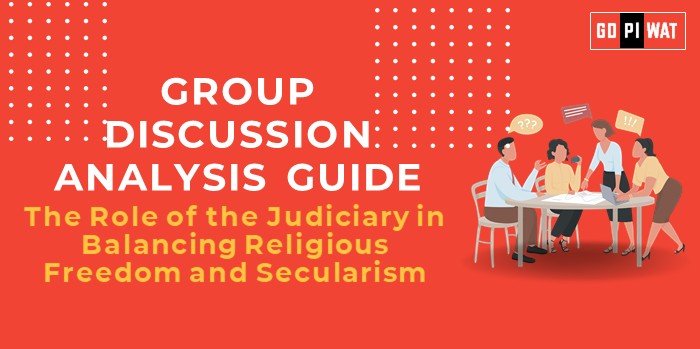📋 Group Discussion Analysis Guide: The Role of the Judiciary in Balancing Religious Freedom and Secularism
🌐 Introduction to the Topic
Balancing religious freedom with secularism is a cornerstone of democratic societies, especially in a pluralistic country like India. The judiciary plays a pivotal role in maintaining this equilibrium by interpreting constitutional provisions in the context of evolving social dynamics.
Topic Background: The tension between religious practices and secular policies has often resulted in legal debates. Landmark judgments like the Sabarimala Temple case and the Babri Masjid verdict exemplify the judiciary’s role in mediating such conflicts.
📊 Quick Facts and Key Statistics
- Article 25: Guarantees freedom of religion while subjecting it to public order, morality, and health.
- Article 26: Allows religious denominations to manage their own affairs within the framework of the Constitution.
- Landmark Case: Sabarimala Temple judgment (2018) upheld women’s right to worship.
- Global Comparison: In the U.S., the Establishment Clause ensures separation of church and state.
👥 Stakeholders and Their Roles
- Judiciary: Ensures that religious freedom aligns with secular principles and constitutional mandates.
- Religious Groups: Advocate for the preservation of cultural and religious traditions.
- Legislative Bodies: Frame laws to balance individual rights and collective harmony.
- Civil Society: Promotes dialogue and inclusivity in policy and judicial decision-making.
🏆 Achievements and Challenges
🌟 Achievements:
- Landmark Judgments: Promoted gender equality and secular values (e.g., Triple Talaq case).
- Safeguarding Minority Rights: Protected the religious practices of minorities under constitutional safeguards.
- Global Comparisons: Echoes the European Court of Human Rights’ efforts to balance individual freedom with societal interests.
⚠️ Challenges:
- Religious Polarization: Rising tensions undermine judicial efforts to foster harmony.
- Global Issues: In France, bans on religious symbols have triggered debates on secularism.
🗨️ Structured Arguments for Discussion
- Supporting Stance: “The judiciary ensures that religious freedoms are exercised responsibly, preserving societal order.”
- Opposing Stance: “Judicial interventions can sometimes encroach upon religious autonomy, causing societal dissent.”
- Balanced Perspective: “While the judiciary is crucial in balancing rights, its actions must be contextualized within cultural sensitivities.”
✨ Effective Discussion Approaches
- Opening Approaches:
- Use a landmark case as an opening statement.
- Start with a thought-provoking statistic, e.g., the global rise in religion-based litigation.
- Counter-Argument Handling:
- Refer to international precedents or use data to substantiate claims (e.g., European Court cases on secularism).
🔍 Strategic Analysis of Strengths and Weaknesses
- Strengths: Upholds constitutional values, fosters inclusivity.
- Weaknesses: Risk of judicial overreach, challenges in uniform application of rulings.
- Opportunities: Promoting dialogue between diverse stakeholders.
- Threats: Religious polarization and political interference.
📈 Connecting with B-School Applications
- Real-World Applications: Explore judiciary’s role in corporate governance where ethical considerations intersect with diversity.
- Sample Interview Questions:
- “How can B-schools learn from judicial approaches to balance diverse stakeholder interests?”
- “What lessons does judicial balancing of religious freedom offer for leadership?”
- Insights for Students: Learn to navigate diverse perspectives while respecting institutional frameworks.


